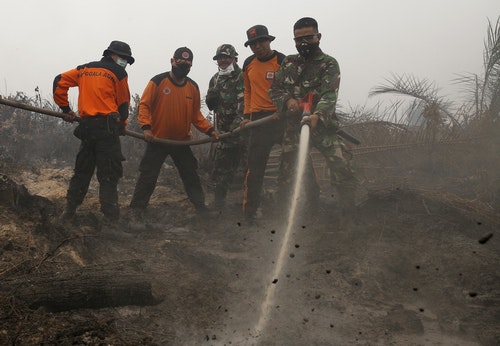JAKARTA, INDONESIA — As ambient air pollution chokes Jakarta amid hosting the Asian Games, many in Malaysia are accusing Indonesia of being responsible for heightened levels of haze, which they say is because of fires in Kalimantan, the Indonesian part of Borneo island.
A smoky haze from fires, exacerbated by hot, dry conditions as well as the result of the deliberate burning of land for agriculture, threatens to spark another diplomatic conflict between Indonesia and its neighbors. A similar rift occurred in 2015 when smoke spread from Kalimantan and Sumatra to blanket Singapore and large parts of Malaysia.
“I continue to invite all parties to care for forests and land. Stop hurting nature by burning,” Siti Nurbaya Bakar, Indonesia’s minister of Environment and Forestry, tweeted Wednesday. “We don’t have plan B, because there is NO planet B.”
Southeast Asia has experienced annual haze during the dry season since at least 2005, in part because of agricultural producers using burning as a cheap and effective way to clear land.
About 60 to 70 percent of fires in 2015 occurred in degraded peatlands, where burning releases an enormous amount of carbon dioxide, producing a particularly noxious form of smog.
Severe respiratory problems
In a paper published in the journal Respirology last month, Malaysian researchers found that hospitalizations for breathing problems increased significantly during periods of haze. Severe respiratory problems accounted for 4 percent of admissions to intensive care units during times of haze, compared to 2 percent generally.
Malaysian social media has been abuzz with accusations that Indonesia is responsible for increased levels of smog in recent weeks.
According to Global Forest Watch, there were more than 17,000 fire alerts across Kalimantan in the past week, the greatest number of which were in West Kalimantan. Its capital, Pontianak, sits more than 900 kilometers (571 miles) east of Kuala Lumpur and is closer in proximity to many Malaysian cities than it is to Jakarta.
Experts say it is unclear, however, whether heightened levels of air pollution in Malaysia are being caused by Indonesian forest fires.
“If there are large fires and the wind is heading that way, there’s a possibility. But to be certain, you’d need analysis of data,” said Dr. Raden Driejana, an air quality expert from the Bandung Institute of Technology. “It’s dry season [in Indonesia], and also in Malaysia, so there could be fires there, too.”
“The fires are getting worse in Kalimantan, but they are still far from those in 1982 and 1997,” Arief Wijaya, climate and forests senior manager at the World Resources Institute (WRI) Indonesia, told VOA.
The World Health Organization said that exposure to ambient air pollution can cause an array of deadly conditions, such as heart disease, strokes, lung cancer, and respiratory infections, in children. More than a half-million Indonesians were estimated to suffer ill health effects from the 2015 blazes.
A study published by scientists from Harvard and Columbia universities in 2016 showed that severe haze in 2015 may have caused more than 100,000 premature deaths in Southeast Asia, a claim downplayed by the governments of Indonesia, Malaysia, and Singapore.
Driejana, the air quality expert, said the administration of President Joko “Jokowi” Widodo has done “quite a lot” since 2015 to address the problem and has had success in reducing the severity of fires, identifying the sources of haze, enforcing newly introduced laws, and providing “a lot of education for the community” regarding the risks of fires.
Steps taken
Indonesia arrested several corporate executives in relation to the 2015 haze, and Jokowi later established the Peatland Restoration Agency under a presidential decree in January 2016 and has focused on fire prevention, mitigation, and enforcement.
But WRI’s Wijaya said, “Fires are only a symptom of weak or failed land use governance.” While big palm oil or paper plantation companies have largely stopped using burning methods for land clearing, “smallholders may have a big role in setting up fires,” he said.
“You can still see things, but when you go out of the house, you need to wear a mask,” Ratri Kusumohartono, a campaigner for Greenpeace Indonesia, told VOA of the current air quality conditions in Pontianak.
After a week in the city of about 235,000 people, Kusumohartono told VOA in a telephone interview that she had been hospitalized for two days and said doctors had reported increasing numbers of casualty admissions for respiratory conditions.
In the past week, local media reported that at least four farmers who were tending their fields were killed when they became trapped in blazes.
“I have also talked with some other NGOs here the past few days and they’re also quite worried that the government is not taking this more seriously, in terms of getting fires out and keeping people safe, because at this point some fires are already a few meters away from people’s housing,” Kusumohartono said. “It’s really time for the government to step up their efforts to manage this.”
Link: https://www.voanews.com/a/concerns-rising-in-ASEAN-over-Borneo-fires-haze/4542338.html



